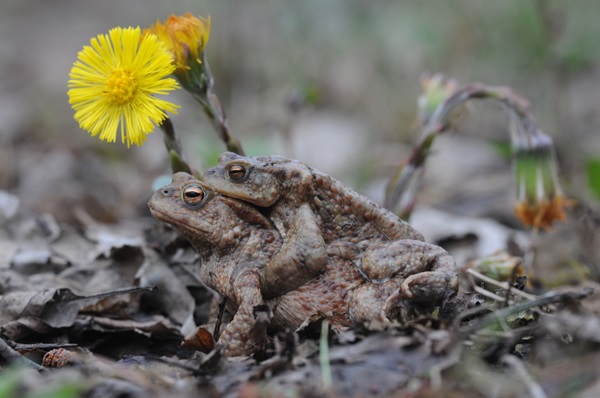 Toads mating;
Credit: © Raymond Gloden
Toads mating;
Credit: © Raymond Gloden
On Wednesday 6 March 2024, natur&ëmwelt Asbl announced details of a census being undertaken around the country's annual migration of toads which has been kicked off by wet weather and rising temperatures
During this period, many roads are crossed by the toads, with some roads having special toad crossings with roadside "fences" to encourage the amphibians to use them.
According to the nature organisation, in collaboration with the Nature and Forestry Administration (ANF), natur&ëmwelt commits every year to make roads safer for amphibians. Knowing migration areas is essential to protect animals through temporary measures such as road closures and rescue operations, as well as to secure dangerous routes through long-term facilities. To this end, a reporting system has been established, flagging risk areas and supporting the planning of rescue operations by volunteers.
Mild night-time temperatures (> 5°C), rainy and humid weather and longer days create the ideal conditions for the annual migration of toads, from their winter quarters (in the forest) to their spawning grounds (ponds, etc.). The migration period extends from mid-February to mid-April, with the start and duration varying depending on weather conditions.
On the way to their nesting sites, amphibians encounter many obstacles, including busy roads. The increasingly dense road network thus represents, in spring, a great threat for toads and other amphibians. Saving toads can only be achieved with the help of volunteers willing to coordinate or participate in collection operations.
How to help?
• If one observes toads crossing the road, take a photo and add an observation to our project on iNaturalist or fill out the online form (https://naturemwelt.wufoo.com/forms/z1cgsxsv08qkyc6/).
• Take part in a rescue operation. Click in Geoportal on one of the migration zones, where an action has been organised (marked in green).
• One can signal a desire to organise a rescue operation using a form (by choosing the type of signaling: “rescue operation”). Here you will find more information on organising rescue operations.








